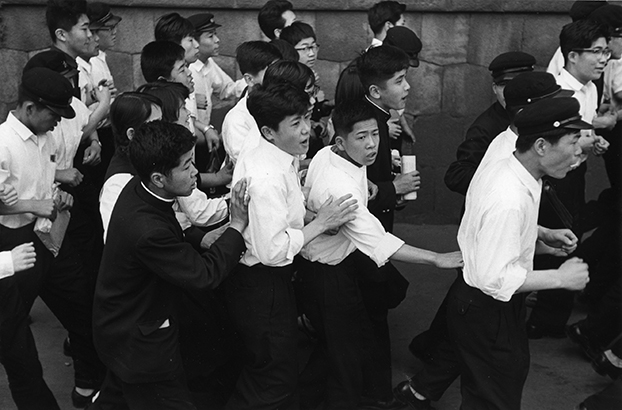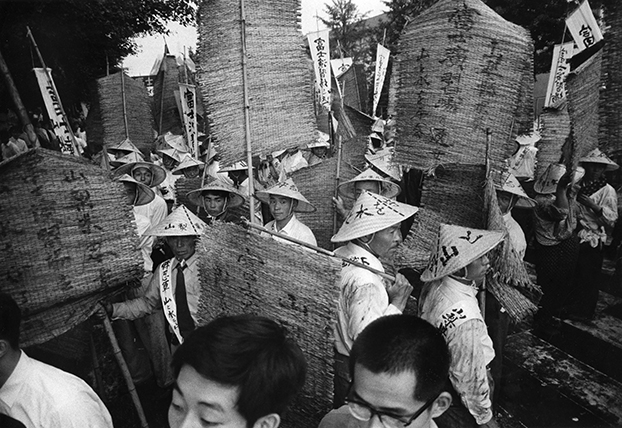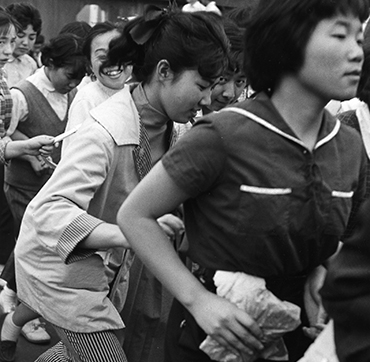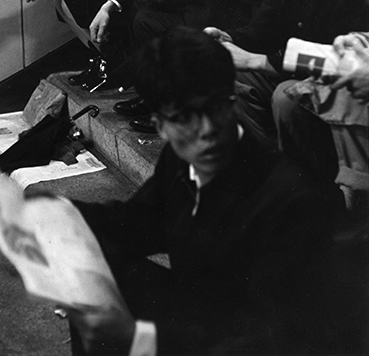| |
“AVERAGE CITIZENS”
Hamaya’s primary subject is people, and for the most part they are not politicians or well-known personages. With the exception of James Hagerty, and a few shots of Asanuma Inejirō, leader of the Socialist Party, the people in Hamaya’s photographs are simultaneously anonymous and individual. A number of the photos were taken at rallies. But almost without exception they ignore the stage, the “front” of the rally, to concentrate instead on the faces of the people in the crowd.
| |
| |
Hamaya almost always focuses on the faces in the crowd, not the leaders. Here, students stage a rally outside the Diet on June 18, the day before the revised security treaty was to automatically become law.
[anp7180]
|
|
| |
The question of who the protestors were and why they were protesting was politically fraught. Kishi portrayed the protests as “riots,” and the protestors as a violent “mob.” Other officials claimed that the protestors were under the sway of Moscow. This claim was echoed in most of the coverage of the protests in the U.S. and U.K. The New York Times ran an editorial on June 13, claiming “the real authors of these demonstrations have been hard-core communists and left-wing socialists mouthing ultra-communist slogans,” while Britain’s Sunday Times ran an article on June 19 titled “20 Communists Directed Tokyo Week of Riots.” [23]
On May 28, Kishi met with reporters for the first time after forcing the revised treaty through the Diet. He famously coined the phrase “voiceless voices” to refer to what he imagined to be the silent majority of Japanese opinion that was not being heard among the din of protests. Incensed, the major newspapers all published scathing editorials the next day, taking issue with Kishi. [24] Seemingly contradicting the argument that the noisy protestors obscured more general support, an Asahi newspaper poll taken on May 25 and 26 showed approval ratings for Kishi’s cabinet to be just 12 percent—the lowest of any prime minister to that point in postwar Japan. [25] Protestors quickly adopted the phrase voiceless voices to refer to themselves. They also began to refer to themselves as “average citizens” (ippan shimin) to capture the idea that protesting did not make them exceptional. They were regular people, responding as concerned parties to the situation.
Hamaya was highly aware of these controversies and criticized the idea that Japan’s voiceless majority supported Kishi in the afterword to the collection of photos he published in Japanese. His distrust of U.S. media coverage led him to refuse a request for his photographs from Life magazine and to send them instead to the French publication Paris Match. [26] His approach to the Anpo protests is also marked by his endeavor to portray the variety of the protestors’ backgrounds. There are men and women, children and elderly, people from all walks of life.
| |
 |
| |
High-school students join the protests on June 11.
[anp7136]
|
|
| |
This man holds what appears to be a People’s Republic of China flag. Judging by his sash, which reads “Japanese resident,” he is probably a Chinese national residing in Japan.
[anp7141]
|
|
| |
In one picture, protestors from a rural area near Mt. Fuji have gathered in Tokyo in preparation for the enormous protests of June 15. They wear rustic hats proclaiming where they’re from, and carry reed signs reminiscent of feudal-era peasant rebellions. The area they were from was the site of a major U.S. maneuvering ground, which had itself seen a long-running local protest against it. U.S. military bases in Japan were the source of a range of social and environmental ills for the communities that hosted them, and came to symbolize the inequality in the relationship between Japan and the U.S. Hamaya’s photo captures how these protestors consciously put forward a self-image as plain old folk participating in the protests out of good sense, to protect the “mountains and water” of their home.
| |
 |
| |
Residents of a rural area near a U.S. maneuvering ground come to Tokyo on June 15 to lend their voices to the protests. Their straw hats and slogans written on woven reed mats hark back to peasant protests and rebellions of the feudal era.
[anp7151]
|
|
| |
Camaraderie
People who participated in the demonstrations and strikes sometimes testified to feeling an unusual ease among strangers—an ability to talk and share with others that went beyond the everyday arrangement of things. That camaraderie, among strangers as well as acquaintances, comes through in many of Hamaya’s photographs.
|
|
 |
[anp7137]
|
[anp7060]
|

|
| |
Hamaya seems relatively uninterested in using formal compositions to enhance the graphic or iconic impact of the events. He does not emphasize the iconicity of the people and places he is photographing. The Diet building or the lights of Ginza may appear, but they are secondary to the crowds moving around them. Major politicians and intellectuals are almost absent. What we encounter instead, over and over, is regular people. Although the historical moment they were participating in was anything but run-of-the-mill, Hamaya’s photos generally refuse to turn them visually into heroes. Although they have moved outside their usual places and routines to demonstrate their ideas and convictions about issues of great significance, they are nevertheless still everyday people.
From one perspective we may think of this as a result of the realities of photographing an unfolding event. Nobody including Hamaya could see where the events were leading, or which of the events would later be seen to have had particular significance. There is thus no visual center of gravity that runs through Hamaya’s photographs. Instead, he is fundamentally following the protestors, and not assuming a perspective that would put him ahead of them. Beyond the realities of recording a developing event, however, we may see this quality in his photographs as involving a positive statement, a conviction, on Hamaya’s part. Insofar as his primary subject was people—simultaneously anonymous in their numbers and unique in their individuality—the neutral, straightforward, even repetitive quality that treats each of them with similar respect in their everydayness is highly fitting.
|
|
| |

|
|
|





